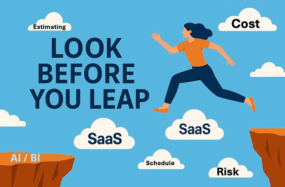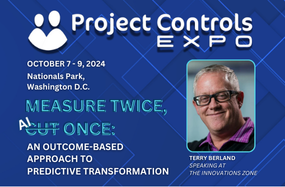
The Death of the Data Warehouse: Why Continuous Data Transformation Is the Future

The Warehouse Dream: Control Through Centralization
For years, IT success has meant control — clean data, centralized systems, predictable costs, and one version of the truth.
Data warehouses deliver that promise. They bring order to complexity, consolidating information from across the enterprise so everyone works from the same source. For a long time, that was enough.
It worked because projects moved slower, data volumes were smaller, and updates happened in cycles. Warehouses gave IT stability, governance, and cost control — the foundations of enterprise confidence.
But the world has changed. Today’s megaprojects generate continuous streams of new information — from the field, the cloud, and dozens of connected systems. Traditional data transformation inside a warehouse is static and batch-based, designed for yesterday’s pace.
Now, that same architecture limits IT’s ability to deliver what project leaders value most: trusted, current data they can act on to keep projects on time and on budget.
The Reality Check: Project Data Doesn’t Sit Still
Yesterday’s model breaks down the moment project data starts moving.
In today’s project environments, information flows across disparate data sources—scheduling, estimating, and field systems — each updating at its own pace. APIs evolve. Schemas drift. And new tools appear faster than IT can secure or standardize them.
Each “quick integration” adds another fragile link to maintain. Soon, IT is spending more time fixing data pipelines than delivering insight — while project leaders wait for answers that are already out of date.
Static architectures simply can’t keep up with the continuous data transformation today’s projects demand. Data must move, adapt, and align in real time if teams are going to trust what they see and act before problems escalate.
And while dashboards help make sense of all that data, they come with their own problem — they only show what they’re given. When there’s too much data and it’s coming from everywhere, dashboards make it look organized, but they’re not always accurate.
The Dashboard Illusion
Dashboards make it feel like everything’s finally in one place — cost, schedule, risk, progress — all lined up and ready to analyze. For project teams, it looks like progress: live numbers, color-coded trends, and layers of metrics that seem to bring order to the chaos.
But beneath that confidence is a hidden weakness. Dashboards can only display what they’re fed, and the data feeding them is often stitched together from disparate sources, cleaned in isolation, and updated in batches. By the time it loads, it’s already out of sync with what’s happening in the field.
IT leaders see this pattern all the time: numbers that don’t match between systems, reports that raise more questions than they answer, and “live” dashboards that quietly lag a day behind reality. Everyone feels informed — but the foundation isn’t solid.
That’s not a dashboard problem — it’s a data transformation problem. Without continuous transformation to align and validate information as it moves, no BI in the cloud platform can deliver accurate insight. Dashboards are great at showing what’s happening — they just can’t guarantee it’s real. In fact, according to Owner Insite, over 80% of contractors reported that one-fourth of their project data was totally unusable, and 50% of construction firms say that they don’t have processes in place to clean and organize their data.
Related reading: Is Self-Service BI Just a Myth?
The Shift: From Storing Data to Transforming It Continuously
Dashboards aren’t the whole problem — but they’re part of it. They make it easy to flood teams with information, not insight. But that’s another story.
The real shift is simpler: data can’t just sit still anymore. It has to move.
Warehouses hold information. Continuous data transformation keeps it in motion — a living, automated process that connects, cleans, validates, and aligns data as it flows between systems.
For IT, this is where the value shows up. It’s what reduces rework, closes gaps between systems, and gives project teams confidence that what they’re seeing is real.
Transformation in motion means less firefighting and more delivery. When data moves in sync, everything else does too.
The Future of Intelligence: Always-On, Always-Accurate
When data finally stays in sync, the work changes. Reports update themselves. Forecasts tighten. Dashboards start showing what’s actually happening instead of what happened last week.
That’s the payoff — data that delivers real business intelligence, not BI maintenance.
When transformation happens continuously, IT stops being the help desk and starts driving strategy. Clean, unified, real-time data feeds AI models, predictive reporting, and dashboards that mirror project reality.
That’s the promise of a Unified Project Platform — data that’s always right, always ready, and always in motion.
For IT, it’s proof of value: faster insight, better decisions, and visible impact across every project. Continuous transformation turns data from background noise into a strategic asset.
Related reading: Inside the Complete Guide to the Unified Project Platform.
The Payoff
When data finally stays in sync, the work changes. Reports update themselves. Forecasts tighten. Dashboards start showing what’s actually happening instead of what happened last week.
That’s the payoff — data that delivers real business intelligence, not BI maintenance.
When transformation happens continuously, IT stops being the help desk and starts driving strategy. Clean, unified, real-time data feeds AI models, predictive reporting, and dashboards that mirror project reality.
For IT and data leaders, this is the shift that matters most:
- From managing data to mobilizing it.
- From building warehouses to building trust.
- From reporting the past to enabling the next decision.
Continuousdata transformation is how IT earns a seat at the strategy table — by delivering data that’s always right, always ready, and always driving value.
Learn More
Want to see how continuous data transformation could work inside your projects to simplify systems, speed up insight, and strengthen every decision? Contact us today to start the conversation.
Related Questions
What is BI in cloud computing?
BI in cloud computing (or BI in the cloud) refers to business intelligence tools and platforms that are hosted in the cloud rather than on-premises. They allow organizations to analyze and visualize data stored and processed over the internet, offering scalability, flexibility, and faster deployment.
What is a BI connector?
A BI connector is a tool or component that links a BI platform or dashboard to various data sources (such as databases, apps, or SaaS tools). It enables the BI system to access, pull, or stream data from those sources for analysis or visualization.
What is an AI-powered dashboard?
An AI-powered dashboard is a dashboard enhanced by artificial intelligence or machine learning. It can automatically analyze data patterns, generate predictions or insights, and let users interact through natural-language queries. Some newer dashboards also use generativeAI to create visualizations, summaries, or explanations based on the underlying data.
Can AI generate reports?
Yes — AI can generate reports. AI-based reporting tools can analyze raw data, identify trends or insights, and produce formatted reports, often automating tasks that used to require extensive manual work.








